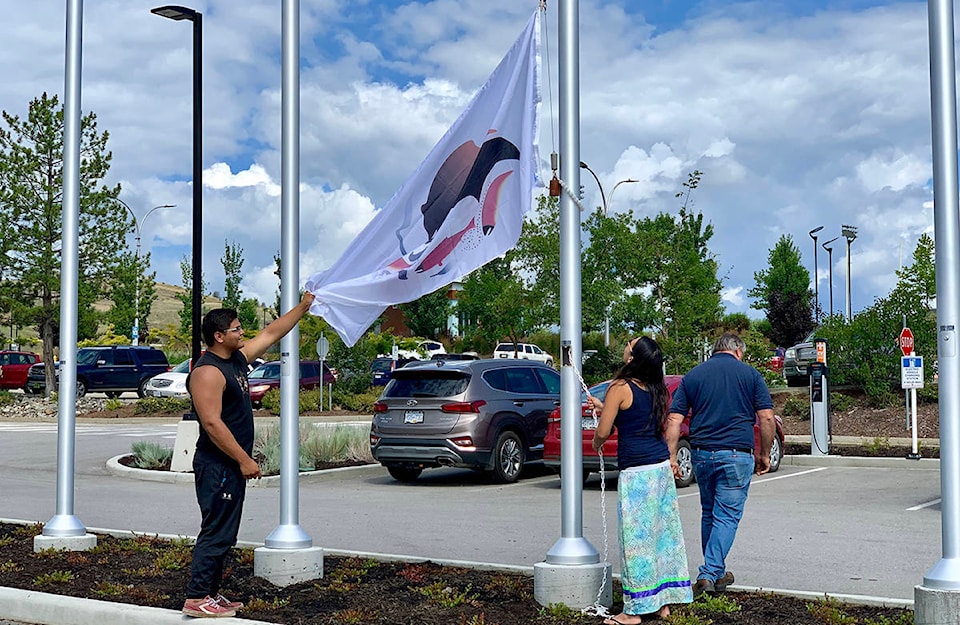Doing the right thing.
For Okanagan College president Jim Hamilton it was a wrong that needed to be righted, a breakdown that needed to be repaired — embracing a reconciliatory rethink of recognizing Indigenous communities served by the college.
Hamilton began that journey as a singular voice of influence in the aftermath of the establishment of UBC Okanagan in 2005 and the impact that had on revamping the identity and mission of evolving what was Okanagan College University into Okanagan College (OC).
Today, with Hamilton set to retire next summer, OC students, staff and supporters have embraced his objective to do the right thing, and in the process changed the post-secondary opportunities for a new generation of Indigenous youth.
| Jim Hamilton |
“There was a big shift in history here, one that calls upon us to recognize some unpleasant truths and commit ourselves to do the right thing,” Hamilton reflected.
Hamilton’s thinking came long before Reconciliation Canada was created in September 2012 with a bold vision to promote reconciliation by engaging Canadians in dialogue that revitalizes the relationships between Indigenous peoples and all Canadians in order to build vibrant, resilient and sustainable communities.
The impact of OC’s renewed connection with Indigenous communities has been dramatic.
It is reflected on the OC board of governors. Current board chair Gloria Morgan and the two recent governor appointees all have Indigenous backgrounds.
Morgan’s predecessor as board chair was Christopher Derickson, the current Westbank First Nation (WFN) chief.
First Nations flags fly at OC campuses and are what Hamilton calls a powerful symbolic message to the people of the Okanagan and Shuswap Indigenous communities that they are welcome on any college campus.
“We’re sending the message this is your college, as much as it is our college,” Hamilton explained.
Other measures adopted have included starting Indigenous childhood education programs, construction and craftwork initiatives, Aboriginal-themed culinary courses, Indigenous garden areas, and the Indigenous cultural presence at grad ceremonies
“We are trying to find practical ways of developing programs to enhance the Indigenous curriculum as there is a strong appetite among our employees to do this,” he said.
Derickson credits Hamilton for being a driving force behind the college’s pathway to reconciliation within its own terms rather than being mandated to do so by a higher level of government.
“It means a lot to me that what he says behind closed doors is exactly the same as what he says in public,” said Derickson.
“What is important to recognize that during Jim’s tenure, the college made Indigenous education a priority long before the reconciliation narrative became fashionable.”
He said WFN students at the college numbered 61 – with 21 having graduated and the rest moving on to pursue university degrees.
OC’s initiatives coincide with efforts in the Central Okanagan School District to foster opportunity for more Indigenous high school students to graduate and get credits for courses about different aspects of Indigenous culture, the result being a 100 per cent graduate rate for WFN students for the past four years.
“We are only in the beginning stages of reconciliation but within our region, I feel Jim has been a crucial part of that,” he said.
“When (Indigenous) kids see their parents, aunts and uncles enrol in post-secondary education, see the barriers removed that existed in the past it gives them the motivation to see their schooling through as well.”
Hamilton has some regrets he won’t see the finish of the next significant phase of the college’s reconciliation initiative, an Indigenous task force, sidelined somewhat by the COVID-19 pandemic.
James Coble, director of student services at Okanagan College and WFN member, is chairing the task force, comprised of representatives from across the college and Indigenous communities.
Coble said the task force aims to advance the symbolic gestures already in place and implement curriculum and administrative commitments towards Indigenous learners.
“It is taking it to another level, and the interesting part is we have a lot of people in the college - the teaching side, the support side, the administrative side of the house - who buy into what has been established at Okanagan College and how to enhance it further,” Coble said.
He admits Hamilton’s influence will be missed, but the passion for this issue that started with him has become part of the college’s DNA.
Hamilton also takes solace in how reconciliation is becoming increasingly reflected within the school system, what kids learn starting at a young age about Canada’s Indigenous cultural history.
For the college, Hamilton is enthused about the spirit of inquiry and willingness to learn, to find acceptance and unity within humanity, which can be parlayed into students’ individual education experiences.
“We want students to be inspired to make this world a better place, regardless of who they are.”
